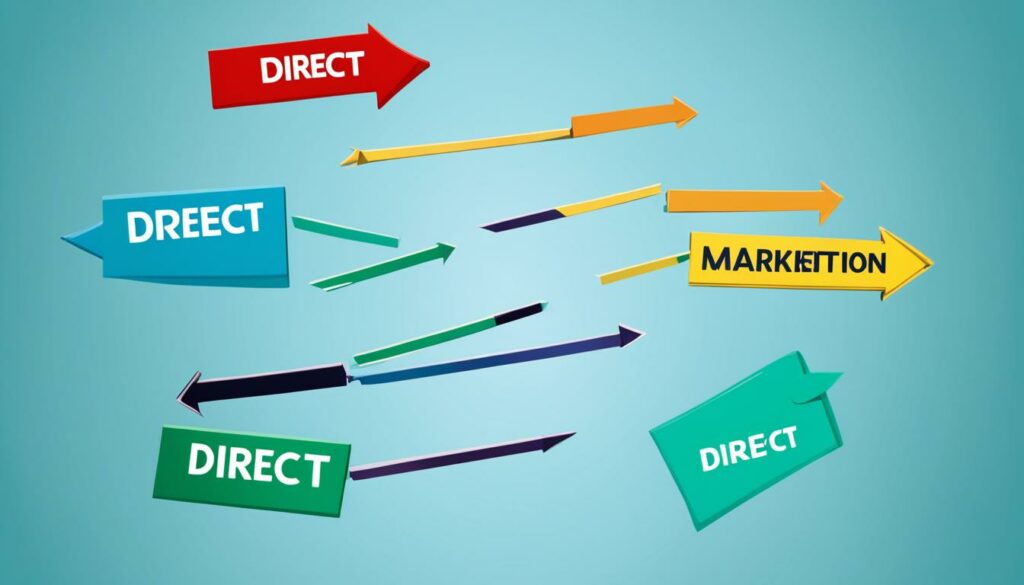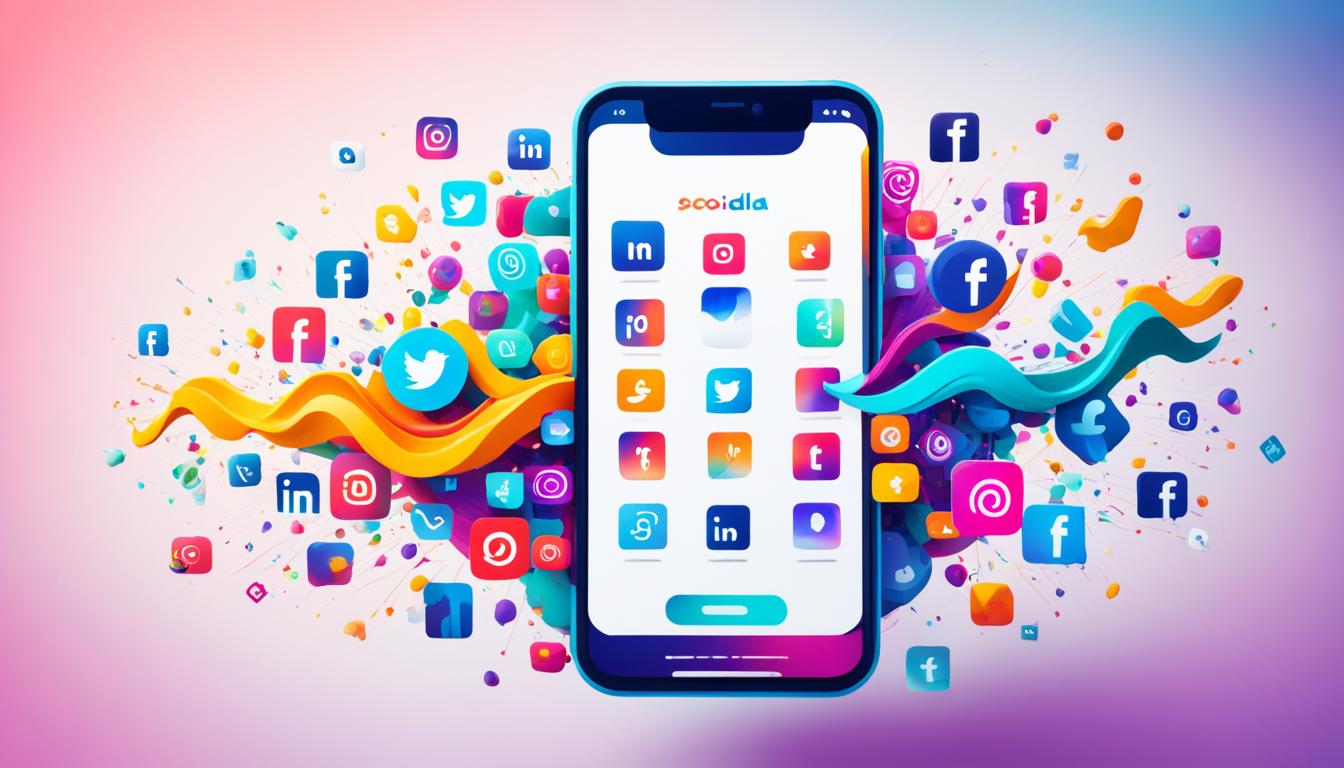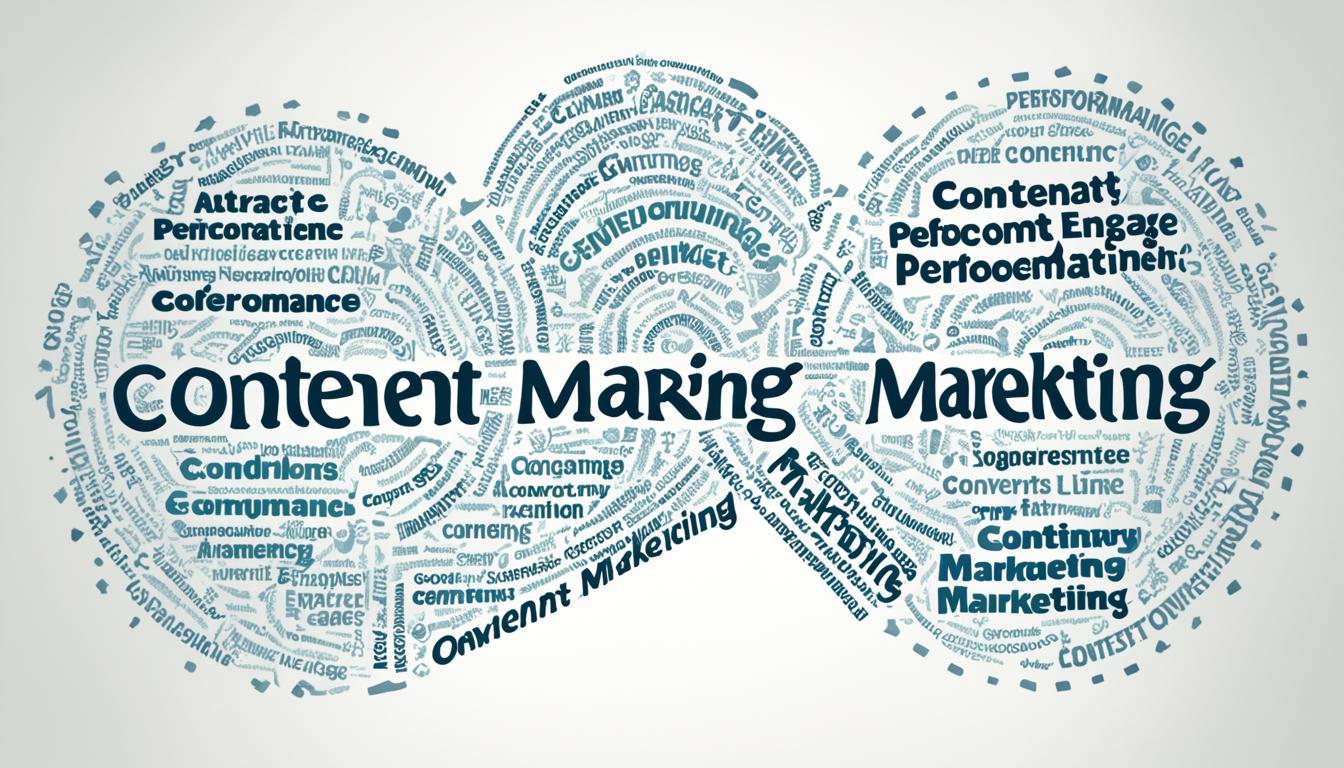In the world of marketing, there are two primary approaches to reaching consumers and driving sales: direct marketing and indirect marketing. While both methods have unique advantages and strategies, understanding the differences between them is crucial for developing a successful marketing strategy. In this guide, we will explore the key distinctions, benefits, and examples of direct marketing and indirect marketing.
Key Takeaways:
- Direct marketing involves directly targeting individuals or groups with personalized messaging and offers.
- Indirect marketing focuses on building brand awareness and engaging with a broader audience.
- Direct marketing offers quick results and measurable outcomes.
- Indirect marketing aims to establish long-term customer loyalty and reputation.
- A successful marketing strategy often utilizes both direct and indirect marketing approaches.
What is Direct Marketing?
Direct marketing is a targeted marketing approach that involves reaching out to specific individuals or groups with personalized messaging and offers. It aims to establish direct communication with potential customers through various channels, including commercials, print ads, sales calls, email marketing, and more. Direct marketing enables businesses to deliver quick results by reaching the right audience with tailored messages.
In direct marketing campaigns, businesses can utilize data-driven strategies to identify and target potential customers based on demographics, interests, past purchases, or other relevant criteria. By personalizing the marketing message and offer, businesses can increase the likelihood of generating customer interest and driving conversions.
Direct marketing offers several advantages over other marketing approaches:
- Targeted Messaging: Direct marketing allows businesses to tailor their messages to specific individuals or groups, ensuring relevance and increasing the chances of engagement and conversion.
- Personalized Marketing: By leveraging customer data, businesses can create personalized marketing materials that resonate with recipients, improving the overall customer experience.
- Quick Results: With direct marketing, businesses can achieve relatively quick results by directly reaching out to potential customers who are more likely to convert.
Direct Marketing Examples
Here are some examples of direct marketing:
- Sending targeted email campaigns to a segmented list of subscribers with personalized offers and promotions.
- Conducting personalized sales calls to prospects who have shown interest in a product or service.
- Running targeted social media ads that reach specific demographics based on location, interests, or user behavior.
By leveraging direct marketing strategies and examples, businesses can maximize their reach, engagement, and conversion rates, resulting in successful marketing campaigns.
| Advantages of Direct Marketing | Direct Marketing | Indirect Marketing |
|---|---|---|
| Targeted Messaging | ✓ | |
| Personalized Marketing | ✓ | |
| Quick Results | ✓ |
What is Indirect Marketing?
Indirect marketing is a strategy that focuses on building brand awareness and engaging with a broader audience in a subtle and non-intrusive way. Unlike direct marketing, which involves direct communication with potential customers, indirect marketing aims to attract and nurture leads over time. By creating valuable content, businesses can provide value to their audience while building relationships that ultimately lead to sales.
Indirect marketing encompasses various tactics and channels, including content marketing, social media marketing, and referral programs. These strategies allow businesses to reach a wider audience and establish brand authority by delivering informative and relevant content.
Brand Awareness and Audience Engagement
One of the key objectives of indirect marketing is to build brand awareness. By consistently delivering valuable content, businesses can establish themselves as industry leaders and gain the trust of their target audience. This helps create a positive perception of the brand and increases the likelihood of customer engagement.
Content Marketing and Social Media Marketing
Content marketing plays a crucial role in indirect marketing. By creating blog posts, social media posts, and informative articles, businesses can educate their audience, address pain points, and establish themselves as authoritative sources of information. This helps in attracting and nurturing leads over time.
Social media marketing is another powerful tool in indirect marketing. Through platforms like Facebook, Twitter, and Instagram, businesses can engage with their audience, share valuable content, and create a community around their brand. Social media provides an opportunity for two-way communication with customers, allowing businesses to build meaningful relationships and increase brand loyalty.
Referral Programs and Other Indirect Marketing Tactics
In addition to content marketing and social media marketing, referral programs are an effective indirect marketing tactic. By incentivizing existing customers to refer new customers, businesses can tap into their customers’ networks and expand their reach. Referral programs leverage the power of word-of-mouth marketing, which is highly trusted by consumers.
Other examples of indirect marketing tactics include influencer partnerships, strategic collaborations with media outlets, and public relations activities. These tactics aim to increase brand visibility and credibility, ultimately leading to brand growth and increased sales.
To sum up, indirect marketing is a strategic approach to building brand awareness, engaging with a wider audience, and nurturing relationships over time. Through content marketing, social media marketing, and other tactics, businesses can provide value to their audience while establishing themselves as trusted authorities in their industry.
Advantages of Direct Marketing
Direct marketing offers several advantages that can significantly benefit a business. By leveraging targeted audience segmentation, personalized messaging, and measurable results, direct marketing allows companies to maximize their marketing efforts and achieve tangible outcomes.
1. Targeted Audience: One of the key advantages of direct marketing is the ability to reach specific audience segments. Through data-driven strategies and market segmentation techniques, businesses can identify and target individuals who are most likely to be interested in their products or services. This targeted approach ensures that marketing messages are delivered to the right people, increasing the chances of generating leads and conversions.
2. Personalized Messaging: Direct marketing enables businesses to tailor their messages according to the preferences, needs, and behaviors of their target audience. By creating personalized content and offers, companies can establish a deeper connection with their customers, enhancing engagement and brand loyalty. Personalization also increases the chances of success, as customers are more likely to respond positively to messages that resonate with their individual interests and pain points.
3. Measurable Results: Another advantage of direct marketing is the ability to measure and track the effectiveness of campaigns. By employing various analytics tools and tracking mechanisms, businesses can gain valuable insights into the performance of their marketing efforts. This data-driven approach allows for continuous optimization, enabling companies to refine their strategies and allocate resources more efficiently.
4. Complementing Indirect Marketing: Direct marketing can complement indirect marketing efforts by providing immediate results while waiting for the long-term effects of indirect marketing to take hold. While indirect marketing focuses on building brand reputation and engaging a broader audience, direct marketing can deliver fast, targeted results that drive immediate sales. By combining both approaches, businesses can achieve a balanced marketing strategy that combines short-term gains with long-term brand building.
In conclusion, direct marketing offers several advantages that can greatly enhance a company’s marketing efforts. With its targeted audience segmentation, personalized messaging, measurable results, and ability to complement indirect marketing strategies, direct marketing provides a powerful tool for businesses to engage their target audience and drive meaningful results.
Advantages of Indirect Marketing
Indirect marketing offers several advantages that can greatly contribute to a brand’s success. By focusing on building brand reputation, being cost-effective, and creating a long-term impact, indirect marketing strategies can effectively engage the target audience and foster customer loyalty over time.
Building Brand Reputation
One of the key advantages of indirect marketing is its ability to build brand reputation. By consistently delivering valuable content and engaging with the audience, businesses can establish themselves as industry leaders and gain the trust of potential customers. Through informative blog posts, engaging social media posts, and other forms of content marketing, brands can showcase their expertise and establish a positive reputation in the minds of consumers.
Cost-Effective Approach
Indirect marketing is often a cost-effective approach compared to other marketing strategies, such as direct marketing. By leveraging content marketing, social media engagement, and other indirect tactics, businesses can effectively reach a wider audience without the need for significant financial investments. This makes it an attractive choice for small businesses or startups with limited marketing budgets.
Long-Term Impact
Unlike direct marketing, which focuses on immediate results, indirect marketing has the advantage of generating long-term impact. By consistently providing valuable content and engaging with the audience, brands can nurture relationships with potential customers, leading to long-term customer loyalty and repeat business. Indirect marketing establishes a foundation of trust and credibility, strengthening the brand’s influence in the industry.
Let’s take a look at some examples of successful indirect marketing strategies:
| Brand | Indirect Marketing Strategy |
|---|---|
| Red Bull | Sponsoring extreme sports events and creating viral content on social media to promote their brand as adventurous and high-energy. |
| GoPro | Encouraging users to share their thrilling adventure videos on social media, effectively promoting their action cameras and inspiring a community of adventurers. |
| The Home Depot | Providing valuable how-to guides and DIY project ideas on their website and social media platforms, positioning themselves as a source of expertise and building trust with customers. |
With its focus on reputation building, cost-effectiveness, and long-term impact, indirect marketing proves to be a valuable strategy for businesses looking to establish a strong presence in the market.
Direct Marketing Strategies
Implementing effective direct marketing strategies is essential for businesses looking to drive sales and reach their target audience. By utilizing various tactics, companies can directly engage with potential customers and increase their likelihood of making a purchase. Here are some key direct marketing strategies to consider:
1. Paid Advertising
Paid advertising is a popular direct marketing strategy that allows businesses to promote their products or services through online platforms such as YouTube, Facebook, and Google’s PPC platforms. By strategically targeting specific demographics and utilizing compelling ad creatives, businesses can effectively capture the attention of their target audience and drive conversions.
2. Sales Calls
Sales calls are a classic and proven direct marketing method that can yield positive results, particularly for certain products or services. By contacting potential customers directly and engaging in personalized conversations, businesses can build relationships, address customer concerns, and ultimately increase sales. It’s important to ensure that sales calls are conducted professionally and adhere to relevant regulations and guidelines.
3. Email Marketing
Email marketing is a highly effective direct marketing tactic that allows businesses to directly communicate with their audience through personalized email campaigns. By segmenting their email lists and tailoring content to specific customer segments, companies can deliver targeted messages, promote products or offers, and nurture customer relationships over time. Email marketing platforms provide valuable analytics and tracking capabilities to measure the effectiveness of campaigns.
4. Direct Mail Marketing
Direct mail marketing involves sending physical mail, such as brochures, postcards, or catalogs, directly to potential customers’ mailboxes. This strategy allows businesses to stand out among digital noise and engage with customers in a tangible way. Direct mail marketing can be especially effective when integrated with digital efforts, such as personalized URLs (PURLs) or QR codes, which drive recipients to specific online landing pages or promotions.

| Direct Marketing Strategy | Advantages |
|---|---|
| Paid Advertising |
|
| Sales Calls |
|
| Email Marketing |
|
| Direct Mail Marketing |
|
Indirect Marketing Tactics
Indirect marketing tactics are essential for businesses looking to build brand awareness, engage with their target audience, and drive long-term success. By implementing these tactics, companies can establish a strong online presence, attract a broader customer base, and nurture relationships for increased loyalty and sales.
Content Marketing
One powerful indirect marketing tactic is content marketing. By creating relevant and valuable content such as blog posts, informative articles, and ebooks, businesses can attract and engage a broader audience over time. Content marketing helps establish a brand as a trusted source of information and positions it as an industry leader. It also provides an opportunity to incorporate keywords and SEO strategies to improve organic search rankings.
Social Media Marketing
Social media marketing plays a crucial role in indirect marketing efforts. By leveraging social platforms such as Facebook, Instagram, and Twitter, businesses can connect with their audience, share valuable content, and nurture leads. Social media provides a platform for building relationships, engaging in conversations, and showcasing brand personality. Through strategic social media marketing, businesses can increase brand visibility, foster customer loyalty, and drive traffic to their website.
Partnerships
Strategic partnerships can significantly amplify indirect marketing efforts. Collaborating with influencers, media outlets, or complementary businesses can extend the reach and credibility of a brand. Partnerships allow businesses to tap into new audiences and leverage the influence and expertise of their partners. By partnering with trusted industry figures or established brands, businesses can gain valuable exposure and access a larger customer base.
Referral Programs
Referral programs are an effective way to leverage existing customers to generate new leads and customers. By incentivizing customers to refer their friends and family to a business, referrals can provide a steady stream of high-quality leads. Referral programs create a sense of trust and social proof, as customers are more likely to trust recommendations from people they know. Implementing a well-structured referral program can greatly enhance the success of an indirect marketing strategy.
Overall, utilizing indirect marketing tactics such as content marketing, social media marketing, partnerships, and referrals can help businesses establish a strong brand presence, engage with their target audience, and drive long-term results. These tactics complement other marketing strategies and play a vital role in attracting, nurturing, and converting leads into loyal customers.
| Indirect Marketing Tactics | Benefits |
|---|---|
| Content Marketing | Attracts and engages a broader audience, establishes brand authority and trust. |
| Social Media Marketing | Increases brand visibility, fosters customer loyalty, drives website traffic. |
| Partnerships | Expands brand reach, enhances credibility, access to new audiences. |
| Referral Programs | Generates high-quality leads from existing customers, builds trust and social proof. |
Direct Marketing Vs Indirect Marketing: A Comparison
When comparing direct marketing and indirect marketing, it’s important to consider the pros and cons of each approach. Direct marketing offers the potential for quick, short-term results and targeted messaging, while indirect marketing focuses on brand building, long-term impact, and broader audience engagement.
Direct marketing, also known as direct response marketing, involves directly reaching out to potential customers and soliciting a direct response. This approach allows businesses to target specific individuals or groups with personalized messages and offers. Direct marketing tactics include email marketing, telemarketing, direct mail, and paid advertising. It can provide quick feedback and measurable results, allowing businesses to adjust their strategies accordingly.
On the other hand, indirect marketing focuses on building brand reputation and nurturing relationships over time. It employs strategies such as content marketing, social media marketing, and public relations to attract and engage a broader audience. Indirect marketing aims to create valuable content that resonates with the target market, fostering trust and loyalty. It may take longer to see measurable results, but it has a long-lasting impact on brand perception and customer loyalty.
| Direct Marketing | Indirect Marketing | |
|---|---|---|
| Goal | Immediate sales | Brand building |
| Approach | Targeted messaging | Content creation and engagement |
| Results | Short-term impact | Long-term impact |
| Pros |
|
|
| Cons |
|
|
By utilizing both direct and indirect marketing strategies, businesses can achieve a balance between immediate sales and long-term brand awareness. Direct marketing can generate quick results and drive immediate revenue, while indirect marketing focuses on cultivating brand reputation and nurturing long-term customer relationships. Ultimately, the success of a marketing campaign lies in finding the right mix of direct and indirect approaches that align with the business’s goals and target audience.
Conclusion
Direct marketing and indirect marketing are two distinct approaches that businesses can use to engage consumers and drive sales.
Direct marketing focuses on targeted messaging and immediate results.
On the other hand, indirect marketing emphasizes building brand awareness and nurturing relationships over time.
Both approaches have their advantages and disadvantages, and a successful marketing strategy often involves a combination of both. By understanding the differences between direct and indirect marketing and leveraging the strengths of each, businesses can effectively engage their target audience and achieve their marketing goals.
FAQ
What is the difference between direct and indirect marketing?
Direct marketing involves directly targeting specific individuals or groups with personalized messaging and offers, while indirect marketing focuses on building brand awareness and engaging with a broader audience over time.
What are some examples of direct marketing?
Examples of direct marketing include targeted email campaigns, personalized sales calls, and targeted social media ads.
What are some examples of indirect marketing?
Indirect marketing tactics include content marketing, social media marketing, referral programs, and more.
What are the advantages of direct marketing?
Direct marketing offers the ability to target specific audience segments, personalize messaging, and track the effectiveness of campaigns through measurable results.
What are the advantages of indirect marketing?
Indirect marketing provides advantages such as building brand reputation, increasing brand trust, and being cost-effective.
What are some direct marketing strategies?
Direct marketing strategies include paid advertising, sales calls, email marketing, and direct mail marketing.
What are some indirect marketing tactics?
Indirect marketing tactics include content marketing, social media marketing, partnerships with influencers, and referral programs.
How do direct marketing and indirect marketing compare?
Direct marketing offers quick, short-term results and targeted messaging, while indirect marketing focuses on brand building, long-term impact, and broader audience engagement.






